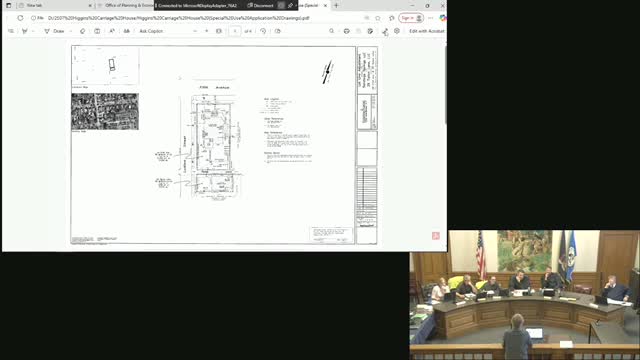Planning Board Approves Special Use Permit for Carriage House Conversion in UR1 Zone
September 25, 2025 | Saratoga Springs City, Saratoga County, New York
This article was created by AI summarizing key points discussed. AI makes mistakes, so for full details and context, please refer to the video of the full meeting. Please report any errors so we can fix them. Report an error »

The Saratoga Springs Planning Board convened on September 25, 2025, to discuss a proposed project involving the conversion of a historic carriage house into a dwelling unit. The meeting featured significant public input, particularly from neighbors concerned about potential rental uses of the property.
The discussion began with a resident expressing concerns about the proximity of the carriage house to their property, emphasizing the potential for increased traffic and rental activity. The resident referenced previous zoning board meetings from 2021, questioning whether the necessary zoning approvals had been obtained for the project, particularly given the close proximity of the structure to neighboring properties.
Board members sought clarification on the status of the zoning approval and the implications of the new Unified Development Law (UDL) on the project. It was noted that the previous application for a variance had been abandoned, and the current proposal was compliant with the UDL, which allows for the conversion of accessory structures into dwelling units.
The conversation shifted to the potential for the newly created dwelling unit to be used as a short-term rental. Board members expressed uncertainty about the current regulations governing short-term rentals in the area, with some noting that the city had recently passed legislation on the matter. Concerns were raised about the impact of short-term rentals on the community's housing stock, as residents feared that such uses could exacerbate housing shortages.
A board member pointed out that while the proposal was for a specific use, the possibility of future short-term rental activity could pose challenges. However, it was clarified that the board's focus should remain on the current application rather than broader concerns about short-term rentals.
Public comments included a reminder that property ownership could change over time, potentially leading to different uses of the property in the future. The board acknowledged the unique nature of the neighborhood, which primarily consists of single-family homes, and the potential implications of introducing a multi-family dwelling.
As the meeting progressed, board members deliberated on the implications of granting the special use permit. They recognized that while the proposal aligned with the UDL, the concerns raised by neighbors about future rental uses could not be entirely dismissed. Ultimately, the board concluded that they lacked the authority to impose restrictions on the property that would prevent it from being used as a short-term rental if permitted by city regulations.
The meeting concluded with a commitment to further review the application and the associated regulations, ensuring that all concerns were adequately addressed before making a final decision. The board's next steps will involve continued discussions on the implications of the project for the community and the potential need for clearer guidelines regarding short-term rentals in residential areas.
The discussion began with a resident expressing concerns about the proximity of the carriage house to their property, emphasizing the potential for increased traffic and rental activity. The resident referenced previous zoning board meetings from 2021, questioning whether the necessary zoning approvals had been obtained for the project, particularly given the close proximity of the structure to neighboring properties.
Board members sought clarification on the status of the zoning approval and the implications of the new Unified Development Law (UDL) on the project. It was noted that the previous application for a variance had been abandoned, and the current proposal was compliant with the UDL, which allows for the conversion of accessory structures into dwelling units.
The conversation shifted to the potential for the newly created dwelling unit to be used as a short-term rental. Board members expressed uncertainty about the current regulations governing short-term rentals in the area, with some noting that the city had recently passed legislation on the matter. Concerns were raised about the impact of short-term rentals on the community's housing stock, as residents feared that such uses could exacerbate housing shortages.
A board member pointed out that while the proposal was for a specific use, the possibility of future short-term rental activity could pose challenges. However, it was clarified that the board's focus should remain on the current application rather than broader concerns about short-term rentals.
Public comments included a reminder that property ownership could change over time, potentially leading to different uses of the property in the future. The board acknowledged the unique nature of the neighborhood, which primarily consists of single-family homes, and the potential implications of introducing a multi-family dwelling.
As the meeting progressed, board members deliberated on the implications of granting the special use permit. They recognized that while the proposal aligned with the UDL, the concerns raised by neighbors about future rental uses could not be entirely dismissed. Ultimately, the board concluded that they lacked the authority to impose restrictions on the property that would prevent it from being used as a short-term rental if permitted by city regulations.
The meeting concluded with a commitment to further review the application and the associated regulations, ensuring that all concerns were adequately addressed before making a final decision. The board's next steps will involve continued discussions on the implications of the project for the community and the potential need for clearer guidelines regarding short-term rentals in residential areas.
View full meeting
This article is based on a recent meeting—watch the full video and explore the complete transcript for deeper insights into the discussion.
View full meeting
